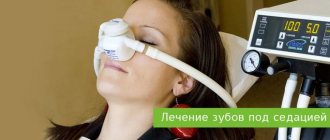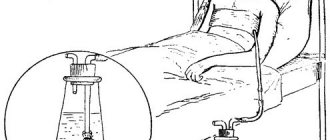Our expert is an anesthesiologist at Branch No. 6 of the Central Military Clinical Hospital No. 3 named after. A. A. Vishnevsky Russian Ministry of Defense Alexander Rabukhin .
Despite the fact that today most people consider themselves to be very “advanced” in matters of medicine, the very word “anesthesia” often has a sharply negative connotation for them. Even those who, in principle, are not afraid of surgery, are usually afraid of anesthesia. But what about: after all, according to a common philistine myth, with general anesthesia, supposedly you may not fall asleep completely, or there is a chance of unexpectedly waking up right during the operation. And many are afraid that they may not wake up at all from medicated sleep. In addition, the opinion that “anesthesia takes away several years of life” is still alive. It is hardly worth taking seriously all these various rumors and prejudices that have no relation to modern reality. Moreover, it is necessary to especially emphasize - specifically to the modern one, because these fears still have some basis. But, fortunately, it is connected with a rather distant history.
Inhalation anesthesia
This is the most commonly used type of anesthesia, which is characterized by ease of implementation, relatively easy control and short duration of action, which is important for minor surgical interventions. Inhalation anesthesia is the administration of drugs through a mask, which ensures their entry into the organs of the respiratory system. Most often, Narcotan, nitrous oxide, Trilene, Ftorotan and Etran are used for this type of anesthesia. There is a certain problem - to achieve the desired result, it is necessary that the effect of anesthesia be deep, and this is fraught with serious complications. Therefore, this type of anesthesia is most often used in pediatric surgery. Children under anesthesia administered by inhalation feel excellent, they do not experience respiratory dysfunction, and complications are extremely rare.
Not everyone can handle it
In recent years, it has become fashionable to treat teeth under anesthesia. A huge number of large and small medical centers have opened that actively advertise such treatment, but they are often completely unsuited to providing safe anesthesia. Meanwhile, dentistry is the only area where general anesthesia can often be associated with significant risks. Even in the USA and Europe, where the level of medicine is significantly higher than in Russia, doctors try to avoid anesthesia during dental procedures. The fact is that in this case, the anesthesiologist does not have access to the respiratory tract, is not able to control their protective reflexes, and cannot always prevent fluid (blood, pus) from flowing into the trachea - and such situations are life-threatening.
| Important | |
| If a patient suffers from bronchial asthma, he should definitely tell the doctor about it. The fact is that with this disease, additional funds may be required during anesthesia. | |
Unfortunately, in our country, the willingness to pay often becomes the main indication - so to speak, “any whim for your money.” Dental treatment under anesthesia is exactly the case when you shouldn’t be capricious without good reason; the price can be prohibitively high. And if there is a real need for this, you must definitely contact specialized centers that have an operating unit with the necessary equipment, it is possible to provide emergency care, and in an emergency, place the patient in intensive care or at least in a post-anesthesia observation ward.
In all other cases, there are no contraindications to general anesthesia. On the contrary, some medical procedures and examinations are much more convenient and safer to do under anesthesia. For example, colonoscopy (examination of the intestines) throughout the civilized world is a necessary procedure for medical examination in people over 50 years of age, and it is necessarily performed under anesthesia. And the point is not only that without anesthesia it can be painful and psychologically uncomfortable. Another point is that if a patient has a bad heart or hypertension, then enduring pain is quite dangerous for him, and this can more often lead to complications than properly administered anesthesia.
Of course, the higher the qualifications of the anesthesiologist, the lower the risk of side effects from the use of anesthesia. And there is only one way out: when preparing for an operation or examination under general anesthesia, you need to choose a medical institution as carefully as possible, go not to where it is “cheaper and closer to home,” but to those specialists who inspire trust. It is better to rely not on intrusive advertising, but on objective information, on the experience of relatives and friends. You should not at all strive to ensure that your anesthesiologist is a candidate or doctor of science; it is much more important that he has extensive experience and extensive practice.
Intravenous anesthesia
This type of anesthesia refers to non-inhalation types of anesthesia, which are characterized by a long-lasting effect and a greater depth of effect compared to inhalation anesthesia. Intravenous anesthesia can be performed using the following drugs:
- Thiopental, Recofol, Oxybutyrate and Propofol - classic pain relief
- Fentathyl with diphenhydramine - neuroleptanalgesia, which can be carried out on spontaneous breathing or combined with artificial ventilation
- Sibazon with Fentathyl is ataralgesia, which provides superficial, gentle anesthesia and can be carried out with other types of anesthesia.
This type of anesthesia is used to remove abscesses and phlegmons that occur with complications; it is also possible to treat small benign tumors if their removal under general anesthesia is not possible.
How long does dental anesthesia last?
This is another important point. It is important for the patient to know that it will not hurt and to understand how long the dental anesthesia lasts. The last factor can be decisive for planning work functions for the rest of the day. Insensitivity increases the risk of injury to the tongue and mucous membranes, which is why dentists recommend refraining from eating and active speech. In the case of conduction anesthesia, problems with diction and swallowing may occur.
find out how long dental anesthesia lasts in your particular case from your attending physician. He selects 1 drug or combination and selects the dosage. The effectiveness of pain relief will depend on the sum of these criteria.
How many hours does it take for the tooth to be anesthetized depends on the drug and dosage
- Drugs with a short duration of analgesia give an effect for 30-60 minutes. For example, novocaine “works” for up to 1 hour, but in combination with adrenaline, the duration of action is extended to 90 minutes.
- The average duration of anesthesia for infiltration injection with lidocaine is 1.5-2 hours.
- Ultracaine - gives a high effect, lasts up to 5 hours, and Bupivacaine can freeze the injection area for up to 8 hours.
to predict exactly how long anesthesia will last for dental treatment for a particular patient only by taking into account all individual factors. Your doctor can guess the average exposure time, but it may vary.
Local anesthesia
Treatment under anesthesia is the only option for providing surgical care to a patient or performing complex manipulations. Often, a doctor will numb a specific area, which is achieved by injecting it with an anesthetic solution and is called local anesthesia. This type of anesthesia is used for opening ulcers, treating teeth, and excising a hernia. Local anesthesia is the injection of an anesthetic into the skin and other anatomical structures of the place where surgery is expected to be performed.
The anesthetic injections are superficial; only in exceptional cases can the doctor administer the drug more deeply. Local anesthesia is performed by injecting the drug through a very thin needle, so the actual anesthesia procedure is minimally painful. Often, the administration of an anesthetic is combined with sedation - sedatives are introduced into the patient’s body, which normalize the person’s psychological state, reducing feelings of anxiety and restlessness.
Despite the fact that local anesthesia is used very widely in medicine, the consequences of anesthesia can be quite serious. For example, local anesthetics can have a negative effect on the heart and brain, leading to heart rhythm disturbances, seizures and loss of consciousness. At the same time, doctors claim that local anesthesia, compared to general anesthesia, is safer for the patient’s health.
There are no absolute contraindications
Now that professionally trained specialists have appeared, as well as high-tech equipment and modern medications, anesthesia has really become one of the safest things in our lives. For those who are best convinced by numbers, we can give the following example: in a relatively healthy person (it is clear that a 100% healthy person usually does not need surgery), the probability of severe complications from the use of anesthesia is 1 case in 200 thousand operations. That is, the risk of dying on the way to the hospital (for example, having an accident or being hit in the head by a brick or icicle from a roof) is 25 times higher than the risk of dying as a result of general anesthesia.
| By the way | |
| Before surgery, you must tell the anesthesiologist about all medications you are taking. This is necessary because many drugs, in addition to their main effects, also have side effects. In addition, when used together, drugs may change their activity and duration of action. For example, taking regular aspirin affects blood clotting; sleeping pills and sedatives can change the body's response to the administration of painkillers. | |
Some patients may experience such unpleasant consequences of anesthesia as nausea, dizziness, temporary memory loss, sore throat, hoarseness, etc. But these sensations, as a rule, pass quickly and do not harm the body. But with competent work of the anesthesiologist and an individual approach to the patient, such phenomena do not happen at all.
The point of view that several anesthesia taken over a short period of time is especially harmful to health has no basis in reality. For example, it is known that patients with severe burns receive general anesthesia often and for a long time (after all, they require regular dressings, as well as skin grafts and plastic surgery), and there is no reliable statistical evidence that anesthesia causes serious complications in them.
Someone was probably confused by the words about a “relatively healthy patient.” It is clear that among those who are routinely placed on the operating table, young and ideally healthy people are not so common. Concomitant diseases - hypertension, angina pectoris, bronchial asthma, etc. - can complicate the work of the anesthesiologist. But this is also the professionalism of an anesthesiologist. After all, this specialist should, before the operation, receive not a formal piece of paper from a neurologist, cardiologist or therapist with the inscription “anesthesia is indicated” or “anesthesia is contraindicated”, but objective information about the person’s state of health.
There are no absolute contraindications to the use of anesthesia, but with some concomitant diseases a certain degree of risk remains, which can and should be minimized. If the anesthesiologist determines that the patient's current health condition is not optimal for anesthesia, he will refer the patient to the appropriate specialist to correct the situation (for example, stabilize his blood pressure).
Endotracheal anesthesia
One of the most commonly used methods of anesthesia when performing complex surgical interventions is endotracheal anesthesia, which involves immersing the body in a state of deep narcotic (medicinal) sleep. At the same time, the muscles completely relax, and the patient does not breathe independently. To achieve the desired state, doctors carry out a set of measures for the patient:
- Tracheal intubation is the insertion of an endotracheal tube into the lumen of the trachea, which is needed to provide artificial ventilation of the lungs.
- Intravenous administration of narcotic anesthetics, sedatives and tranquilizers.
- Administration of muscle relaxants – they block neuromuscular transmission.
- Artificial ventilation.
The quality of endotracheal anesthesia depends not only on the experience of the anesthesiologist, but also on how correctly the patient’s condition is monitored. It is imperative to monitor blood pressure, pulse, and oxygen saturation.
After general anesthesia
Even after a good general anesthesia, in the first hours there is short-term confusion, disorientation in space and time, drowsiness, nausea, and dizziness. As the anesthetic drugs wear off, pain appears in the postoperative wound, but it is successfully relieved by the administration of strong anesthetics.
After general anesthesia with an endotracheal tube, patients complain of pain and sore throat caused by irritation of the mucous membrane of the upper respiratory tract, but this symptom, like nausea, passes very quickly. As a rule, patients feel well 3-4 hours after surgery, and on the second day they leave the clinic and return home.
Rule three. Recovery from anesthesia depends on the type of anesthesia and the characteristics of the body.
Typically, the patient recovers from anesthesia within one to four hours, depending on the amount of anesthesia used and his individual characteristics. The fact that recovery from anesthesia was normal can only be assessed by a doctor based on various indicators of the body’s functioning.
The patient himself usually remains half asleep for quite a long time during the day. His relatives who are present should not be afraid. The patient's body is simply under the influence of analgesics. They are necessarily administered in order to alleviate pain after surgery - after all, the anesthesia has ended, but the cause of the pain remains.
Article on the topic
In facts and figures: epidural anesthesia does not work for 1 in 20 patients
There may be another condition after anesthesia - excessive excitement. This usually happens if a person has previously abused alcohol or had mental problems. This complication is also amenable to medical control - the patient will simply be given sedatives and sleeping pills for a while.
"Semax 0.1%" - a faithful friend of neurons
Recovery from anesthesia can be challenging if you don't plan ahead. Anesthesia can lead to hypoxia Hypoxia
Decreased oxygen content in the body or individual organs and tissues.
brain and, as a result, to disruption of metabolic processes. In this case, the patient “recovers” from anesthesia for a long time due to dysfunction of the nerve pathways caused by a lack of oxygen in the neurons. Neuron
A nerve cell consisting of a body and processes extending from it. Structural unit of the nervous system..
Violations affect:
- Restoration of higher nervous activity
- The functioning of the respiratory, cardiovascular, digestive and excretory systems
The likelihood of recovery increases if negative consequences after anesthesia are minimized in the first postoperative hours.
Semax is an effective remedy and a faithful assistant in the prevention of complications after anesthesia; it promotes the rapid restoration of the activity of functional brain systems that provide vital processes. With Semax, a person will be able to recover from anesthesia quickly and with the least risk.
What foods can you eat?
You need to switch to a special diet at least 3 days before the examination. It is better if this period is 5-6 days. The following products are allowed to be consumed:
- Low-fat cheeses, kefir.
- Eggs.
- Buckwheat porridge.
- Boiled lean meat.
- Boiled fish of low-fat varieties.
- Honey, sugar, jelly.
- Mashed potatoes (small quantities).
If you are having a colonoscopy, you need to pay maximum attention to preparing for the procedure at home. Diet violations should not be allowed; this can lead to the accumulation of gases and feces in the intestines, which will greatly complicate the examination.
Pain relief without harm: how to recover from anesthesia?
The onset of a post-anesthesia state is much easier to prevent than to overcome. The drug “Semax 0.1%” is perfect for this purpose. Unique regulatory neuropeptide Neuropeptide
Or regulatory peptide - these are compounds of amino acids that regulate various functions in the body.
"Semax 0.1%" has proven itself to be effective both as a prophylactic dose before surgery and in the treatment of complications after anesthesia . The therapeutic effect of Semax 0.1% is to prevent dysfunctional disorders of the parts of the central nervous system that are most affected during general anesthesia.
Rule two. Follow the anesthesiologist's recommendations
The anesthesiologist must talk to you the day before if you are undergoing elective surgery. Tell us in detail about all the problems that bother you and how you endured anesthesia before.
Take seriously the regimen that you will be advised to follow before the operation - do not smoke, do not drink liquids. It is prescribed to prevent complications and extreme situations.
Article on the topic
Advice from an anesthesiologist: Which anesthesia is safer?
If you are prescribed any medications the night before or the morning before surgery, do not ignore this order. As a rule, strong sleeping pills are prescribed before surgery, which already represent the first stage of anesthesia. They will ensure that you get a deep, relaxing sleep before surgery and that other painkillers work properly.










